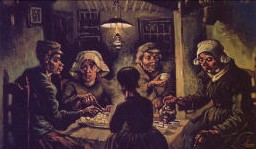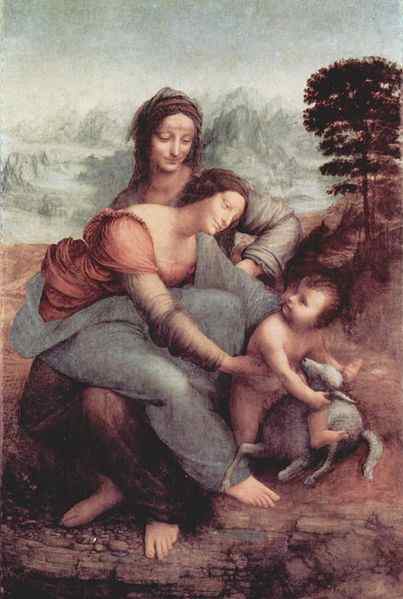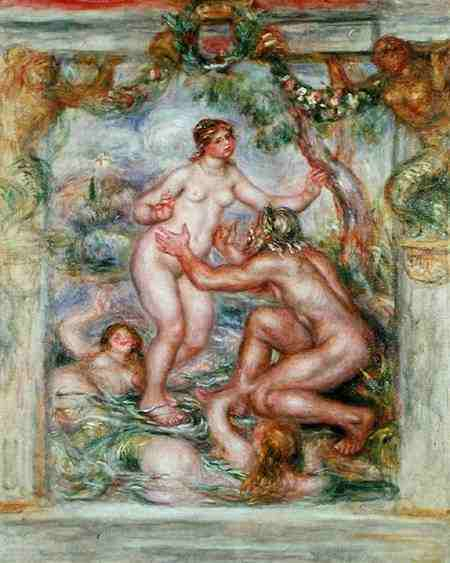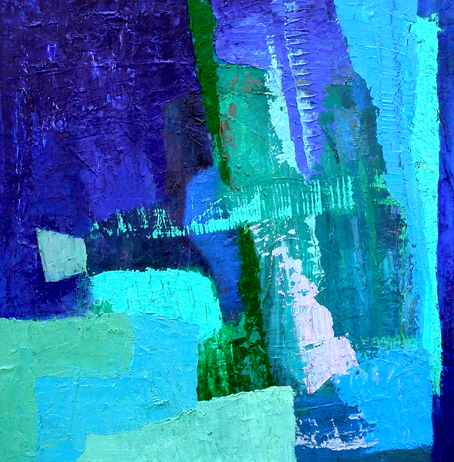ABSTRACT art IS NOT ART
by
ROBERT J. LEWIS
_____________________
We
are in a diseased state
because we mix up art
with a respectful attitude
towards decoration. Le Cobusier
Is it
art, is the question now being asked of abstract painting? In
his brilliant The Voices of Silence André Malraux
characterizes abstract art as something about nothing, and then
laments that the word ‘art’ is used when referring
to both good and bad art.
 In
1989, the National Gallery of Canada purchased Barnett Newman’s
"Voice of Fire" for 1.8 million. It’s a work comprised
of 3 vertical stripes. For many, myself among them, this purchase
and others like it constitute overwhelming proof that our most
esteemed curators -- the first-world’s elite untouchables
-- dwell in catastrophic hebetude. They are complicit in a century
deep fraud distinguished by highly inventive art criticism that
is typically more substantial than the vacuous artwork itself.
Among the rush of critics who have shown themselves incapable
of distinguishing between decoration and art, I mention Toronto’s
John Bentley Mays in his salivations over Agnes
Martin; Robert Fulford in his waxations over Mr.
Newman; the late Anne Duncan in her extolations of
Yves Gaucher and Guido
Molinari; and Henry Lehman for whom relativism
in the visual arts is not a symptom of cultural suicide but a
point of departure. No less responsible than the artist for bringing
the visual arts to its nadir, their serene pronouncements would
not have been possible without the constancy of unbonfired vanity,
and illusions of grandeur that come from being able to program
the content of the spaces we set aside for art.
In
1989, the National Gallery of Canada purchased Barnett Newman’s
"Voice of Fire" for 1.8 million. It’s a work comprised
of 3 vertical stripes. For many, myself among them, this purchase
and others like it constitute overwhelming proof that our most
esteemed curators -- the first-world’s elite untouchables
-- dwell in catastrophic hebetude. They are complicit in a century
deep fraud distinguished by highly inventive art criticism that
is typically more substantial than the vacuous artwork itself.
Among the rush of critics who have shown themselves incapable
of distinguishing between decoration and art, I mention Toronto’s
John Bentley Mays in his salivations over Agnes
Martin; Robert Fulford in his waxations over Mr.
Newman; the late Anne Duncan in her extolations of
Yves Gaucher and Guido
Molinari; and Henry Lehman for whom relativism
in the visual arts is not a symptom of cultural suicide but a
point of departure. No less responsible than the artist for bringing
the visual arts to its nadir, their serene pronouncements would
not have been possible without the constancy of unbonfired vanity,
and illusions of grandeur that come from being able to program
the content of the spaces we set aside for art.
The very
best that has been said about abstract painting is found in two
seminal essays written by Meyer Schapiro in 1937 and again in
1957. His aim was to articulate the principles and motivation
underlying abstract’s fresh approach to painting, but he
may have inadvertently provided the best arguments against it
as a serious art form. From his essay entitled "Recent Abstract
Painting":
“In
abstraction . . . are endless tangles and irregular curves,
self-involved lines which impress us as possessing the qualities
not so much of things as impulses, of excited movements emerging
and changing before our eyes.” The genre introduced “chance”
and “randomness” that “corresponds in turn
to a feeling of freedom, an unconstrained activity at every
point . . . painting, by becoming abstract and giving up its
representational function, has achieved a state in which communication
seems to be deliberately prevented.”
In trying
to get a critical handle on an art that is opaque and self-referential,
Schapiro introduces the notions of “mastery of the formless
and accidental,” and “impulsively scribbled forms.”
One cannot
help but notice that all of the above could be used to describe
the method and art of the child.
What
is perhaps most telling – code for disconcerting -- as it
concerns the genrefication of abstract art, is that for the first
time in the history of the visual arts there need not be a consensus
on what an individual painting means. What can we say about the
word ‘book’ if for someone it means egg, for another
ice and for another sub-atomic particle? In order for a word to
become meaningful, to enter the stream of language, there must
be a consensus on what it means. For meaning to be meaningful,
it must be shared. The red traffic light at the corner of Sherbrooke
and Atwater is meaningful because it means ‘stop’
to those who encounter it.
 Van
Gogh’s “Potato Eaters” is meaningful precisely
because it gathers to it a consensus of meaning. Art critics and
layman alike encounter unhappy as opposed to happy faces, deprivation
instead of plenitude. The work stands and endures as art because
it evokes a consensus of meaning that transcends both the passage
of time and unlike cultures. It is a landmark in its depiction
of poverty and deprivation and fills a gap in an idiom where previously
there had been none.
Van
Gogh’s “Potato Eaters” is meaningful precisely
because it gathers to it a consensus of meaning. Art critics and
layman alike encounter unhappy as opposed to happy faces, deprivation
instead of plenitude. The work stands and endures as art because
it evokes a consensus of meaning that transcends both the passage
of time and unlike cultures. It is a landmark in its depiction
of poverty and deprivation and fills a gap in an idiom where previously
there had been none.
Like
a broken off satellite component no longer subject to gravity
and drifting in outer space, abstract painting represents a radical
break from everything prior to it, especially since it is no longer
the artist but the viewer who determines the content and meaning
of the work. As a manifesto, its unspoken founding utterance can
still be heard: “unskilled, unschooled painters of the world
unite.”
Abstract
falls roughly into four broad categories, with only the first,
Cubism, worthy of mention as a serious art form. Its most distinguished
and rightly celebrated players were Picasso, Braque, Léger
and Duchamps, who wanted to free painting from the tyrannies of
representation. Inspired by Cézanne, they fought to eliminate
perspective and the foreground-background differential, but could
not have foreseen what would happen to that initially brave impulse.
Finding
Braque over reliant on the conventional paint brush, Mondrian
turned to the ruler and introduced the world to geometric art
whose volumes underscored a growing appetite for simplicity and
ready-made symmetries. But those wilfully weighted geometries
would not satisfy the restless spirit of Jackson Pollack, who
single-handedly invented abstract expressionism. Think of the
sport of baseball, but instead of a pitcher hurling a ball, Pollack
is hurling paint. He was doubtlessly inspired by the sport’s
colourful play by play. We speak of a pitcher’s skill in
painting the corners. Pollack, despite a career that was cut short
by acute alcoholism and for whom the weight, width and feel of
the brush were more important than its bristle, to this day is
regarded as one of the great right handers of all time. But abstract
would have to wait until the advent of minimalism for its crowning
hubris: from Rothke and Newman and their epigones, one-colour
canvases became de rigueur and overnight the western
world found itself awash in artists.
Notwithstanding
the above arguably tendentious summary, is there any evidence
or principles we can adduce to make the claim that is overwhelmingly
self-evident to even the least trained eye that abstract painting
isn’t art? To make what I think is an obvious, theoremetic
point, is that if I -- who would be hard pressed to deliver a
circle with the aid of a digital compass -- can do it (or copy
it), it’s not art. It’s as simple as that. The doubters
among you are invited to examine the works below and decide which
one answers best to the criteria of art and which one to decoration.
And if you find yourself in a Sophie’s Choice quandary,
you should by no means be discouraged from taking aim at the defective
mind reflected in the mirror, but rest assured you possess the
necessary qualifications for the position of museum curator.


In his
Ways of Seeing, John Berger writes: “True originality
is never something sought after . . . it is a quality belonging
to something touched in the dark and brought back as a tentative
question.” Since great art has always been singled out for
its uniqueness and inimitability, the issue of whether or not
abstract painting is art has already been solved because we are
all capable of producing paintings that, citing Schapiro, are
“formless, random and accidental.” And when this style
of work pleases us, which it often does, it has every right to
be recognized for what it is: decorative. In this sense, abstract
deserves to be ranked with the likes of wall paper, computer graphics,
laquered wood, hanging rugs and any number of pleasing shapes
and designs we use to decorate our living and working spaces.


The controversial
career of Andy Warhol, American entrepreneur par excellence, is
not unrelated to the institutional depravity that continues to
allow for what is trite and banal in painting to masquerade as
art. Besides wanting to make an easy buck, Warhol wanted to prove
that the American purchaser of art was the least discerning on
the planet. He made his case by cajoling the collector to consider
as art its very opposite: the mass produced. He removed the wrap-around
label from a Campbell’s soup can, blew it up to 10 times
the original size and sold it as an artwork for thousands of dollars
– an event that was roundly praised by America’s major
art critics who, in that same bankrupt spirit, raised to spectacular
eminence the polarizing Pop art movement.
The best
that can be said about decorative is that it reveals nothing beyond
its colours, materials and textures and that its meaning is as
arbitrary and ephemeral as April’s first flowers whose intrinsic
value is roughly commensurate to the price fetched at the market
place. Which makes the decision, underwritten by the nation’s
most esteemed art critics and curators, to dispense millions of
tax payers dollars on canvases comprised of a couple of stripes
or pencil lines an indictable offense.
To finally
right this most reprehensible wrong, I propose that effective
immediately all abstract painting be reclassified as decorative
until it demonstrably meets the criteria of high art. If painting
is to be restored to its former high standing and distinction,
it must dedicate itself to weeding out all pretenders and wanna-be
artists who have convinced themselves that an original or outrageous
work will transform their God-given mediocrity into an enduring
truth. Since a writer, to be considered as such, must possess
writing skills, is it asking too much that an artist be required
to demonstrate the ability to draw?
As a
final consideration, you’re invited to inspect an untitled
abstract by the Canadian painter
Roberto Romei Rotondo and ask yourself if what
you see is mere decoration -- or art for the rock of ages?
